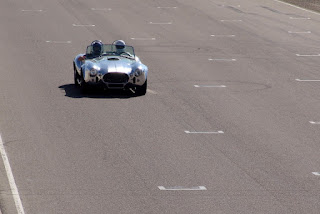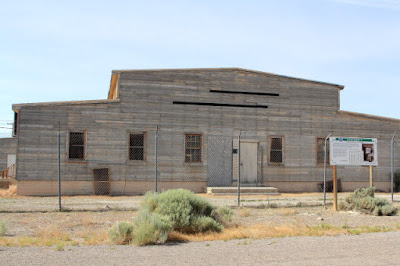The hike up to the "Y" kind of reminded me of a hike we did up to Timpanogos Cave a number of years ago. (Timpanogos Cave is just east of Highland, a few miles north of the "Y.") Except, the hike to Timpanogos Cave was more strenuous and there was no ice cream at the end of the hike!
.
One day while we were ridding our bikes around Lehi, we encounter some really unusual lawn-art. Darcy - They even had dancing frogs! (It even looks lake Darcy standing next to the bike!)
After installing four new 80,000-Mile Michlin Tires, two new rear-axle grease seals and wheel bearings, and some exhaust system repairs, it was time to get back on the road. Or, as Henry David Thoreau said in 1862, "Eastward I go only by force; westward I go free;" so we headed westward into the sunset!
As you drive West out of Salt Lake City, the Miller Motorsports Park is located northwest of Tooele and just south of Highway 138. On a previous occasion, my daughter managed to get me an invitation to a closed event that was primarily for Cobra owners, with a few other vehicles owners allowed to attend. We even had the opportunity to ride is some of the vehicles. Great time! (The only thing that I don't understand is why I had on street clothes with a short-sleeve shirt and the driver had on full racing attire!)
"Saltair" was once known as the "Coney Island of the West" and is just north of the Miller Motorsports Park on the shore of the Great Salt Lake. However, after the first two "Saltair" structures were destroyed, and as the Great Salt Lake water levels fluctuated over the years, tourism declined and the current "Saltair" structure is now only used for concerts and other special events.
 |
| Original Saltair - Photographer Unknown |
Traveling across the Bonneville Salt Flats, Metaphor: The Tree of Utah (aka the Tree of Life) looks out of place. The 87-foot tall sculpture contains six spheres coated with Utah natural rock and minerals. Although I did not see a plaque, it was reported that at the base of the sculpture there is a plaque with the words Ode to Joy, which is from the chorus of Beethoven's Ninth Symphony. I'm uncertain of the meaning of the plaque. A visitor center was also planned for the site, but it has never been funded or constructed.
There are various land speed events held on the salt flats each year that typically start sometime during the summer months and run into early fall, depending on the weather. Unfortunately, none of the events were being held when we visited the site. However, I did taste the salt and it really is salt.
 |
| Date and Photographer Unknown |
In 1940 the military acquired 1,822,000 acres of land near Wendover (Utah) for a bombing range, which was the larges bombing and gunnery range in the United States. During WW II they also used the facility to develop guided missiles, pilotless aircraft, atomic bomb loading techniques, practice atomic bombing drops, and remotely controlled bombs. By 1943 there were 2,000 civilians employees and 17,500 military personnel at Wendover. By 1945 the base consisted of 668 buildings, a 300-bed hospital, gymnasium, swimming pool, library, chapel, cafeteria, bowling alley, two movie theaters, and 361 housing units.
In 1943 preparation began at Wendover for dropping an atomic bomb. Since the Americans did not have a plane with a bomb-bay large enough to carry an atomic bomb, it was suggested that the military use a British Avro Lancaster. However, the director of the Manhattan Project insisted that an American-built plane be used, so five Boeing B-29 Superfortress aircraft were extensively modified to carry atomic bombs and sent to Wendover.
Lt. Colonel Paul Tibbets, an experienced combat pilot who had also been a B-29 test pilot, was chosen to lead a select group of pilots and crews to be trained at Wendover for dropping atomic bombs. Special bombs (without nuclear material) were constructed that had the weight and shape of "Little Boy" and "Fat Man" (the proposed atomic bombs) and were used for practice bombing runs. Special loading techniques were developed at Wendover, so that the atomic bombs could be fitted into the bomb-bays of the special modified planes.
On about August 4, 1945 Colonel Tibbets declared the pilots and equipment combat tread to drop an atomic bomb and all control was transferred from Windover to Tinian, which is where the planes left from that dropped the atomic bombs on Hiroshima and Nagasaki. "Little Boy," the smaller of the two bombs was dropped on Hiroshima on August 6, 1945. The bomb weighed 9,700 pounds, was 10 feet long, 25 inches in diameter, had an explosive yield of 15,000 tons of TNT, and had blast effects at ground zero of 980 mph winds with a temperature of 7,000 degrees. A few days later, "Fat Man" was dropped on Nagasaki, which ended the war.
Today, the Windover Air Base is used as a civil airport with unusually long runways (there are two 8,000-foot long runways). The Enola Gay B-29 hanger is currently being renovated and an attempt is being made to have a restored B-29 Superfortress housed at this location.
 |
| Enola Gay Hanger - Being Restored |
 |
| Practice bomb |




































































No comments:
Post a Comment